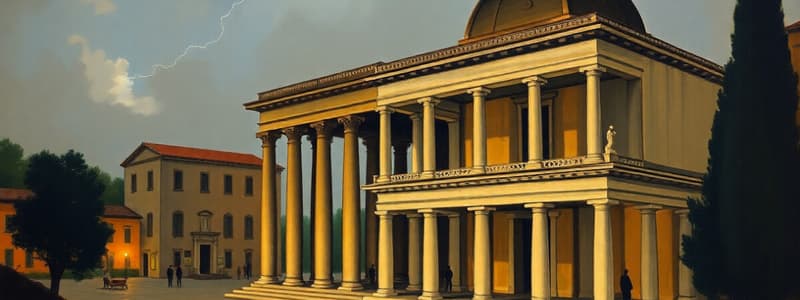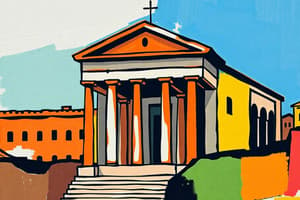Podcast
Questions and Answers
Vilken struktur präglade den tidiga romerska republiken mest?
Vilken struktur präglade den tidiga romerska republiken mest?
- En militärdiktatur
- En aristokratisk styrelse (correct)
- En demokratisk regering
- En teokratisk organisation
Vilken roll hade konsulerna i den romerska republiken?
Vilken roll hade konsulerna i den romerska republiken?
- Utrikeshandlare
- Chefsverkställande med militär och civil myndighet (correct)
- Lagstiftare med obegränsad makt
- Rådgivare till senaten
Vad var en av de huvudsakliga orsakerna till den romerska republiken expansion?
Vad var en av de huvudsakliga orsakerna till den romerska republiken expansion?
- Militära framgångar och erövringar (correct)
- Inrikeshandel
- Fiendernas svaghet
- Ökad diplomati med grannländer
Vilket syfte hade senaten i den romerska republiken?
Vilket syfte hade senaten i den romerska republiken?
Vilken var en av de största sociala konflikterna i den romerska republiken?
Vilken var en av de största sociala konflikterna i den romerska republiken?
Vilken samhällsstruktur var typisk för det romerska samhället?
Vilken samhällsstruktur var typisk för det romerska samhället?
Vilken institution representerade medborgarnas röst i den romerska republiken?
Vilken institution representerade medborgarnas röst i den romerska republiken?
Vilken roll hade slavarna i den romerska republiken?
Vilken roll hade slavarna i den romerska republiken?
Vad var en betydande följd av de politiska spänningarna mellan patricier och plebeier?
Vad var en betydande följd av de politiska spänningarna mellan patricier och plebeier?
Vad bidrog till den politiska instabiliteten i den romerska republiken?
Vad bidrog till den politiska instabiliteten i den romerska republiken?
Vilken konflikt hade en betydande inverkan på den romerska republikens politiska och sociala landskap?
Vilken konflikt hade en betydande inverkan på den romerska republikens politiska och sociala landskap?
Vilka individer var kända för sina militära ambitioner under den sena republiken?
Vilka individer var kända för sina militära ambitioner under den sena republiken?
Vad karakteriserade den sena romerska republiken?
Vad karakteriserade den sena romerska republiken?
Vad signalerade mordet på Julius Caesar?
Vad signalerade mordet på Julius Caesar?
Vilken påverkan hade den romerska republiken på västerländsk politisk tanke?
Vilken påverkan hade den romerska republiken på västerländsk politisk tanke?
Vilken roll spelade de väldiga och komplexa institutionerna i den romerska republiken?
Vilken roll spelade de väldiga och komplexa institutionerna i den romerska republiken?
Vilka konsekvenser hade maktstriderna mellan generallärare och politiker på den romerska republiken?
Vilka konsekvenser hade maktstriderna mellan generallärare och politiker på den romerska republiken?
Vilken av följande var en viktig ingenjörsbedrift under den romerska republiken?
Vilken av följande var en viktig ingenjörsbedrift under den romerska republiken?
Vad kännetecknar det västra arvet från den romerska republiken?
Vad kännetecknar det västra arvet från den romerska republiken?
Flashcards
Romerska republiken
Romerska republiken
En republik som växte fram från det romerska kungadömet på 500-talet f.Kr.
Patricier
Patricier
De romerska eliten, aristokratin med stor makt.
Plebejer
Plebejer
Vanliga medborgare, inte i eliten.
Konsuler
Konsuler
Signup and view all the flashcards
Senaten
Senaten
Signup and view all the flashcards
Folkmöten
Folkmöten
Signup and view all the flashcards
Magistrater
Magistrater
Signup and view all the flashcards
Romerska legioner
Romerska legioner
Signup and view all the flashcards
Rätten och lagarna
Rätten och lagarna
Signup and view all the flashcards
Slaveri
Slaveri
Signup and view all the flashcards
Romerska republiken
Romerska republiken
Signup and view all the flashcards
Generalers makt
Generalers makt
Signup and view all the flashcards
Ekonomisk ojämlikhet
Ekonomisk ojämlikhet
Signup and view all the flashcards
Inbördeskrig
Inbördeskrig
Signup and view all the flashcards
Punic Wars
Punic Wars
Signup and view all the flashcards
Senare republiken
Senare republiken
Signup and view all the flashcards
Julius Caesars mord
Julius Caesars mord
Signup and view all the flashcards
Romersk arv
Romersk arv
Signup and view all the flashcards
Demokrati och republik
Demokrati och republik
Signup and view all the flashcards
Militärorganisation
Militärorganisation
Signup and view all the flashcards
Study Notes
Foundation and Early Development
- The Roman Republic emerged from the Roman Kingdom in the 6th century BCE, following the overthrow of the last king.
- Early political structures were largely aristocratic, with power concentrated in the hands of patricians (elite families).
- The Republic was initially governed by elected officials, including consuls, senators, and various magistrates.
- The concept of the "rule of law" began to develop, with laws codified and publically accessible.
- The early Republic faced internal conflict between patricians and plebeians (commoners), leading to social unrest and political struggles.
Key Institutions
- Consuls: Chief executive officers, holding supreme military and civil authority. They held office for one year, with a system of checks and balances to prevent abuse of power.
- Senate: An advisory body comprised of senior patrician officials that became increasingly influential over time, affecting legislation and foreign policy.
- Assemblies: Various popular assemblies (e.g., the centuriate assembly, the tribal assembly), represented the citizenry. These assemblies could vote on legislation and elect officials.
- Magistrates: Various officials (praetors, censors, quaestors) with specific responsibilities in areas like law, finance, and public works.
Expansion and Conquest
- The Roman Republic's expansion was fueled by military success. Successful campaigns brought significant wealth and resources to Rome.
- Military organization (e.g., legions) played a crucial role, with disciplined and well-trained soldiers.
- Conquest of neighboring territories brought new resources and access to both land and manpower.
- Trade and commerce flourished throughout the expanded Republic.
Social Structures
- The rigid social hierarchy was a defining feature. Patricians held significant privileges while plebeians struggled for greater equality.
- Citizenship was a significant concept, with varying rights and obligations depending on standing.
- Slavery was widespread and played a crucial economic role in the Republic.
- Various social classes such as merchants and artisans played key roles, alongside slaves, and other levels of citizens.
Political Tensions and Crises
- Political factionalism between patricians and plebeians continued throughout the Republic's history, with occasional periods of severe unrest and violence.
- The rise of powerful generals and their influence over the military became a major threat to the Republic, contributing to political instability.
- Economic inequality and social unrest further destabilized the Republic.
- The growing economic disparities between the rich and poor led to civil strife and political instability.
- Notable conflicts, like the Punic Wars, significantly impacted the Republic's political and social landscape.
The Late Republic
- The late Republic was marked by escalating civil wars and political assassinations, culminating in the collapse of traditional institutions.
- The rise of powerful individuals (e.g., Marius, Sulla, Julius Caesar) and their military ambitions dramatically impacted Republican governance.
- The complex interplay of political maneuvering and military strength contributed to the weakening of the Republic.
- The eventual assassination of Julius Caesar signaled an end to the Republic.
Legacy of the Republic
- The Roman Republic had a profound impact on Western political thought and legal systems, inspiring conceptions of democracy, republicanism, and the rule of law.
- Its military organization and strategy influenced generations of military leaders.
- The Republic's engineering feats and infrastructure development set a precedent for future civilizations.
- The Republic's vast and complex political system formed institutions and structures that still resonate today.
Studying That Suits You
Use AI to generate personalized quizzes and flashcards to suit your learning preferences.




